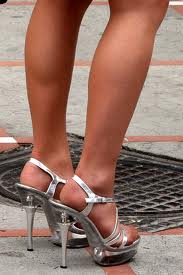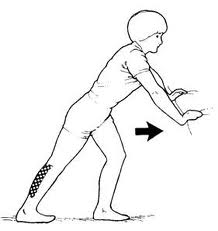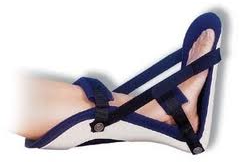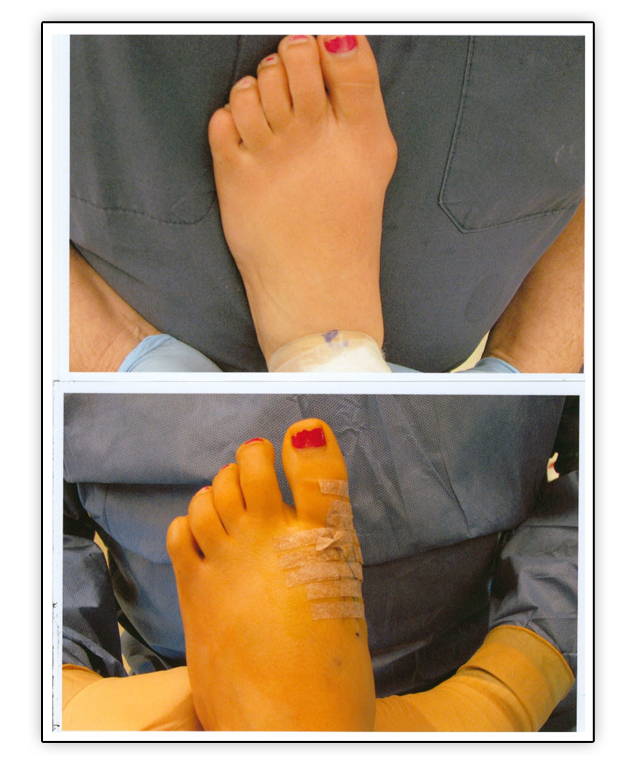The Tight Gastrocnemius – Is it the Root of Most Foot pathology?
By: Michael Zapf, DPM, MPH, FACFAS
If you were referred to this article after your office visit it was because you, or your child, have a condition that is contributing to or even causing a lot of your foot symptoms. The condition is called Gastrocnemius Equinus (GE). I admit that it is a tough concept to understand, but I am going to give it a shot.
The gastrocnemius muscle is a big calf muscle. Doing heel raise exercises, where you stand on the ball of your foot, makes the muscle bigger and stronger and gives the leg a shape many people find attractive. The top of the muscle is attached to your thighbone, the femur, and the bottom of the muscle forms part of the Achilles tendon which attaches on the bone at the back of your foot called the calcaneus. An interesting anatomical fact is that the Achilles tendon is composed of two muscles: the soleus, which is found only deep and behind the calf muscle and is almost never a problem, and the more superficial and bigger gastrocnemius muscle which is frequently a cause of pain and symptoms.
When you walk this muscle contracts and lifts your heel off the ground which propels you forward. In many people the gastrocnemius muscle is short or tight which leads to problems like flat feet, bunions, metatarsalgia, capsulitis, curled fifth toes, hammertoe’s, sesamoiditis, plantar fasciitis and Achilles tendon inflammation, tendinitis, and even Achilles tendon rupture.
 We test for tightness of this muscle by measuring the amount of motion at the ankle joint with the knee flexed and extended. I will try to avoid the mechanics of this test which only tends to confuse people but adequate ankle joint up motion, or dorsiflexion, with the knee flexed or bent, and a lack of ankle joint up motion (dorsiflexion) with the knee straight is called the Silfverskiold test. A lack of ankle joint dorsiflexion is a positive test meaning that the patients have a distinct lack of up motion (dorsiflexion ) due to a very tight gastrocnemius portion of the Achilles tendon. According to an article in the May 2011 Podiatry Today by Stephen L. Barrett, DPM the tight gastrocnemius muscle accounts for the overwhelming majority of foot problems and is largely ignored during examination and treatment.
We test for tightness of this muscle by measuring the amount of motion at the ankle joint with the knee flexed and extended. I will try to avoid the mechanics of this test which only tends to confuse people but adequate ankle joint up motion, or dorsiflexion, with the knee flexed or bent, and a lack of ankle joint up motion (dorsiflexion) with the knee straight is called the Silfverskiold test. A lack of ankle joint dorsiflexion is a positive test meaning that the patients have a distinct lack of up motion (dorsiflexion ) due to a very tight gastrocnemius portion of the Achilles tendon. According to an article in the May 2011 Podiatry Today by Stephen L. Barrett, DPM the tight gastrocnemius muscle accounts for the overwhelming majority of foot problems and is largely ignored during examination and treatment.
Very tight Achilles tendons are also quite common. One study showed that 88% of patients with forefoot and midfoot pain and pathology had gastrocnemius equinus. It is so common that we almost assume everybody has it and we tend to ignore its role and importance in foot pathology.
 So, how do you treat GE? The most common therapy is a stretching routine. This stretch involves standing on the ground facing a wall. With 1 foot you take a step halfway to the wall. Keep the knee of the foot in the back straight and the heel on the ground and leaned forward. You need to hold the stretch for 20 seconds without bouncing. Then repeat the exercise with the other foot. A proper stretch would involve each foot being stretched for 20 seconds three times. This is the most simple two-minute stretch available for GE and should be done with everybody who has a tight Achilles tendon before every athletic encounter. This will warm up the calf muscle and tendon so that it will not be hurt during physical activities.
So, how do you treat GE? The most common therapy is a stretching routine. This stretch involves standing on the ground facing a wall. With 1 foot you take a step halfway to the wall. Keep the knee of the foot in the back straight and the heel on the ground and leaned forward. You need to hold the stretch for 20 seconds without bouncing. Then repeat the exercise with the other foot. A proper stretch would involve each foot being stretched for 20 seconds three times. This is the most simple two-minute stretch available for GE and should be done with everybody who has a tight Achilles tendon before every athletic encounter. This will warm up the calf muscle and tendon so that it will not be hurt during physical activities.
A better method to stretch the type gastrocnemius muscle is using a night splint. With a night splint the Achilles tendon and gastrocnemius muscle is stretched for 3 to 8 hours at a time. This is an aggressive way to stretch the Achilles tendon and the gastrocnemius muscle. Even this aggressive stretch is not very effective, however, one study showed that only 2°-3° of improvement were made after using a night splint for an entire year. The photograph to the right shows a night splint attached in the foot. Honestly, it is not as uncomfortable as it looks. In truth, however, the main advantage to a night splint for a tight Achilles tendon is the ability to say we tried something conservative before recommending or suggesting a surgery.
improvement were made after using a night splint for an entire year. The photograph to the right shows a night splint attached in the foot. Honestly, it is not as uncomfortable as it looks. In truth, however, the main advantage to a night splint for a tight Achilles tendon is the ability to say we tried something conservative before recommending or suggesting a surgery.
Since the Achilles tendon is tight a traditional conservative treatment has been using a heel lift. This will allow the foot to function with a tight gastrocnemius muscle and Achilles tendon. This can be done by wearing shoes that have a heel or by inserting heel lifts under the heel inside the shoe. Because the tight gastrocnemius tendon produces so much pain and pathology relaxing the tendon with an elevated heel often produces surprising pain relief. This is why women in higher heeled shoes and man in a cowboy boot often state that their feet feel more comfortable with the heel elevation. Raising the heel has some drawbacks, however. Raising the heel encourages bunions, hammertoe’s, sesamoiditis and pain and swelling under the ball of the foot. Pain in the front and the ball of the foot is why women, and men, tend to wear lower heeled shoes as they progress through life.
For those people who have pathologically tight Achilles tendon and stretching and heel lifts have not provided enough relief of pain, there are surgeries designed to lengthen the tendon. This is not as radical as it sounds. As I stated above, a tight Achilles tendon is at the root of most foot problems. Unfortunately, addressing the tight Achilles tendon with Achilles tendon lengthening is the singular most neglected surgical procedure on the foot and leg. Even in our office we are guilty of lengthening this tendon in only the most severe cases. Lengthening the tendon necessarily weakens the muscle by a few percentage points. It requires a period of physical therapy and rehabilitation. Because of this difficulty we often ignore the problem and the surgery.
The traditional Achilles tendon lengthening involves a surgery with an incision on the back of the leg and performing a technique that lengthens the tendon. Recently, Dr. Darren Payne introduced us to the concept of an endoscopic Achilles tendon lengthening. This procedure requires only a half-inch incision and can be done under just a little sedation.
One place where we tend to truly pay attention to the type Achilles tendon and the gastrocnemius muscle is with children. Children with painful flat feet almost invariably have the complication of a tight gastrocnemius muscle. We will always start with orthotics, stretching, a night splint and heel lifts but, sometimes, this is not enough. If a surgical approach is ever contemplated, it will always involve lengthening a tight gastrocnemius muscle. Fortunately, children have a much greater ability then we adults to bounce back from this surgery.
In conclusion, a tight Achilles tendon, especially the gastrocnemius portion, is one of the major causes of foot pathology and pain. Unfortunately, it is usually and frequently ignored. It is the chief cause of painful flat feet in children and adults. Nearly every adult with a painful collapsing flat foot, and there are many in the senior years, has the flat foot because of a tight gastrocnemius muscle. This muscle is that important. Heel lifts and stretching can help. Stretching the physical therapy helps even more. When conservative measures do not help we need to think more often about the benefits of Achilles tendon lengthening surgery.
If you have any questions about this topic, or would like an exam by one of our doctors, please feel free to contact us via our contact page here, or give us a call anytime!





4 thoughts on “The Tight Gastrocnemius: Is it the Root of Most Foot Pain?”
do you take medicare/i have hammertoes,bunions,pain in the ball of my feet my ankles are always are swollen
Mr. Chessy,
Yes we do take Medicare. We would be more than happy to see you and figure out how we can treat those issues you are having. Please give our front desk a call to make an appointment, all the numbers you will need are here, http://conejofeet.com/contact/
Take Care and Hope to See You Soon,
Dr. Stephen Benson, DPM
Thanks for posting this – what a helpful article. I have had this condition since childhood (1960s) but it was only recognized as flat feet. The only treatment provided was arch supports, which felt like rocks in my shoes. Now that I’m in my 50s, foot pain is becoming much more severe. I’ll work on the stretching!
Suzanne,
I am so glad you found the article helpful! Unfortunately, there are many cases of progressing pain, and people are left without much guidance on varying ways of dealing with it. I hope this, at the very least, leads you down a path to recovery in the not too distant future. Let us know how the stretching goes after you have had a chance to try it out for a fee weeks.
Feel better,
Michael Zapf, DPM